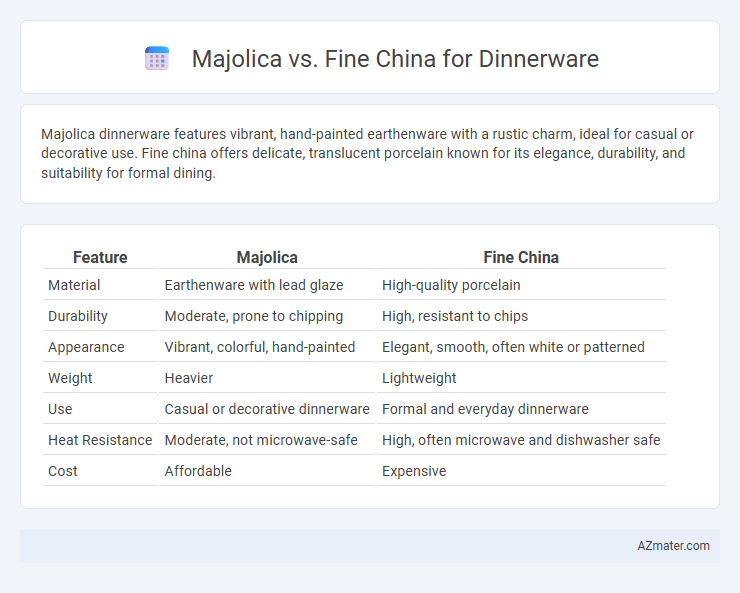Majolica dinnerware features vibrant, hand-painted earthenware with a rustic charm, ideal for casual or decorative use. Fine china offers delicate, translucent porcelain known for its elegance, durability, and suitability for formal dining.
Table of Comparison
| Feature | Majolica | Fine China |
|---|---|---|
| Material | Earthenware with lead glaze | High-quality porcelain |
| Durability | Moderate, prone to chipping | High, resistant to chips |
| Appearance | Vibrant, colorful, hand-painted | Elegant, smooth, often white or patterned |
| Weight | Heavier | Lightweight |
| Use | Casual or decorative dinnerware | Formal and everyday dinnerware |
| Heat Resistance | Moderate, not microwave-safe | High, often microwave and dishwasher safe |
| Cost | Affordable | Expensive |
Introduction to Majolica and Fine China
Majolica is a type of earthenware pottery characterized by its vibrant, colorful glaze and intricate hand-painted designs, originating from Renaissance Italy. Fine china, typically made from porcelain, is renowned for its delicate, translucent quality and durability, often featuring elegant patterns and a smooth, glossy finish. Both materials serve distinct aesthetic and functional purposes in dinnerware, with Majolica offering rustic charm and Fine china exuding refined sophistication.
Historical Background of Majolica and Fine China
Majolica originated during the Italian Renaissance, known for its vibrant, tin-glazed earthenware decorated with intricate, colorful patterns that reflected Mediterranean cultural influences. Fine china, or porcelain, traces its roots to 14th-century China, gaining prominence for its delicate craftsmanship, translucent white body, and durability achieved through high-temperature kiln firing. Both styles represent significant advancements in ceramic technology and artistry, with majolica emphasizing decorative glazing techniques and fine china highlighting refinement and strength.
Material Composition Comparison
Majolica dinnerware features earthenware clay with a tin glaze that creates a brightly colored, opaque surface but remains more porous and less durable compared to fine china. Fine china, also known as porcelain, is composed of kaolin clay fired at higher temperatures, resulting in a denser, translucent, and more chip-resistant material. This fundamental difference in material composition influences the strength, finish, and suitability for everyday use of each dinnerware type.
Design and Aesthetic Differences
Majolica dinnerware features vibrant, hand-painted designs with bold colors and intricate patterns that emphasize rustic charm and artistic flair. Fine china, on the other hand, showcases delicate, refined aesthetics with smooth, translucent surfaces often decorated with subtle gold or platinum accents for an elegant, timeless look. The contrasting styles reflect Majolica's playful, folk-art roots versus fine china's sophisticated, luxurious appeal.
Durability and Practicality in Daily Use
Majolica dinnerware is highly durable due to its thick, glazed earthenware composition, making it resistant to chipping and suitable for everyday use. Fine china, while elegant and lightweight, tends to be more fragile and prone to cracking, requiring careful handling and often reserved for special occasions. For practical daily use, Majolica offers superior resilience and ease of maintenance compared to the delicate nature of fine china.
Maintenance and Care Requirements
Majolica dinnerware requires careful hand washing with mild detergents to preserve its colorful glazes and prevent chipping, as it is more porous and less durable than fine china. Fine china is typically dishwasher-safe but benefits from gentle handling to avoid cracks and crazing, given its delicate porcelain composition. Both materials should be stored separately, ideally with soft padding, to maintain their pristine appearance over time.
Price Range and Value
Majolica dinnerware typically offers a more affordable price range, making it accessible for everyday use and casual dining settings, whereas fine china commands higher prices due to its intricate craftsmanship and premium materials. The value of Majolica lies in its vibrant, hand-painted designs and durability, while fine china holds long-term investment appeal through its elegance, translucency, and suitability for formal occasions. Consumers seeking durable, artistic dinnerware at a budget-friendly cost often prefer Majolica, while those prioritizing luxury, prestige, and heirloom quality often choose fine china.
Suitability for Formal vs Casual Dining
Majolica dinnerware, with its vibrant colors and hand-painted designs, is ideal for casual dining and outdoor gatherings, offering a lively and informal aesthetic. Fine china, characterized by its delicate porcelain and elegant patterns, suits formal dining occasions, enhancing the sophistication and refinement of the table setting. Choosing between Majolica and fine china depends on the desired ambiance and event formality, where fine china elevates special occasions while Majolica brings charm to everyday meals.
Popular Brands and Collections
Majolica dinnerware, known for its vibrant, hand-painted ceramics, is popular in collections by brands like Bordallo Pinheiro and Vietri, offering artisanal styles with intricate floral and fauna motifs ideal for rustic or eclectic table settings. Fine china dinnerware, favored for its delicate translucency and durability, is famously produced by brands such as Royal Doulton, Wedgwood, and Noritake, with collections like Royal Doulton's Contemporary and Wedgwood's Jasper offering timeless elegance for formal dining. Both Majolica and fine china serve distinct aesthetic preferences, with Majolica emphasizing colorful, decorative craftsmanship and fine china focusing on refined, classic designs.
Choosing the Best Option for Your Table
Majolica dinnerware, with its vibrant, hand-painted surfaces and rustic charm, offers a unique, artisanal appeal well-suited for casual or eclectic table settings. Fine china, often crafted from high-quality porcelain and characterized by its delicate translucence and classic designs, provides an elegant and durable option ideal for formal dining occasions. Choosing between Majolica and fine china depends on your style preference, intended use, and maintenance willingness, with fine china typically requiring more careful handling but offering greater sophistication and resilience for long-term use.

Infographic: Majolica vs Fine china for Dinnerware
 azmater.com
azmater.com